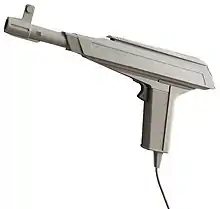 | |
| Developer | Atari Corporation |
|---|---|
| Manufacturer | Atari Corporation |
| Product family | Atari 8-bit family |
| Type | Light gun |
| Generation | Second and third (8-bit era) |
| Release date | 1987 |
| Introductory price | $34.95 |
| Input | Light pen |
| Best-selling game | Bug Hunt |
| Backward compatibility | Atari XEGS, 7800, and 2600 |
The Atari XG-1 light gun is a video game controller which was released in 1987. As Atari's only light gun, it is unique to the 8-bit family. It is compatible with the Atari XEGS, and with the 7800 and 2600 home video game consoles. It was bundled with the XEGS Deluxe home computer and video game console combination system,[1] and with the light gun game Bug Hunt for the 7800 as model XES2001 for US$34.95 (equivalent to about $90 in 2022).[2] Atari eventually released five light gun games on the 7800 (Alien Brigade, Barnyard Blaster, Crossbow, Meltdown, and Sentinel) and one on the 2600 (Sentinel).
Hardware
The XG-1 is a specialized light pen. Generic light pen support was built into the Atari 8-bit home computer family since its 1979 launch. The Atari 400/800 Hardware Technical Reference recommends a calibration procedure each time a light pen is used, so that the software can compensate for this offset for maximal accuracy. Bug Hunt and Barnyard Blaster for the XEGS each have unique hard-coded values.[3][4] A reddish-orange version of the gun was planned for the 2600 and 7800 but was never released.[1]
Games
Sentinel is the only game released for the gun on the 2600 console, and Shooting Arcade was planned but never released.[5]
| XG-1 light gun games | ||
|---|---|---|
| Year | Title | Platforms |
| 1987 | Bug Hunt | XEGS |
| 1987 | Crossbow | 7800 and XEGS |
| 1988 | Barnyard Blaster | 7800 and XEGS |
| 1990 | Alien Brigade | 7800 |
| 1988 | Crime Buster | XEGS |
| 1990 | Meltdown | 7800 |
| 1992 | Operation Blood | XEGS |
| 1993 | Operation Blood II – Special Forces | XEGS |
| 1987 | Gangsterville | XEGS |
| 1990 | Sentinel | 2600 and 7800 |
| Unreleased | Shooting Gallery | 2600 |
Reception
For Antic magazine in August 1988, Matthew Ratcliff criticized the poor horizontal accuracy of the XG-1 light gun compared to the NES Zapper or the Sega Light Phaser.[6] In December 1988, he said that, to switch between light gun and joystick games, active XEGS gamers are frustrated by the need to continually re-plug their devices and power cycle the system, due to the system's lack of autodetection, which is complicated by its awkwardly downward slanting ports. He said "Barnyard Blaster and Bug Hunt could have been just a bit smarter" by including the simple routine that the magazine was forced to write and publish as a workaround.[7]
In the August 1989 issue of A.N.A.L.O.G. Computing magazine, Matthew Ratcliff wrote a front page feature on programming the XG-1 in users' custom software, including his program allowing the light gun to be used to make menu selections. He gave the XG-1 a positive review, calling it an "exciting alternative to joysticks". He said it "has much more 'noise' in the horizontal direction than vertical" due to hardware limitations.[2]
The 2014 book Vintage Game Consoles also criticized its accuracy compared to Nintendo and Sega, but says it became collectible as Atari's only light gun.[4]
See also
References
- 1 2 "Peripheral Power". Retro Gamer UK. No. 124. p. 76. Retrieved March 1, 2021.
- 1 2 Ratcliff, Matthew (August 1989). "Gun Assist" (PDF). A.N.A.L.O.G. Computing. No. 75. LFP Inc. p. 58. ISSN 0744-9917. Retrieved March 1, 2021.
- ↑ "The Toy Store: Shootout of the games systems". Paleotronic. No. 2. April–June 2018. p. 96. Retrieved March 1, 2021.
- 1 2 Loguidice, Bill; Barton, Matt (2014). Vintage Game Consoles. Focal Press. p. 66. ISBN 9780415856003. Retrieved March 1, 2021.
- ↑ Weiss, Brett (2007). Classic Home Video Games, 1972–1984 A Complete Reference Guide. McFarland. p. 103. ISBN 9780786432264. Retrieved February 26, 2021.
- ↑ Ratcliff, Matthew (August 1988). "First look inside the Atari XE Game system". Antic. Vol. 7, no. 4. pp. 43–45. Retrieved March 1, 2021.
- ↑ Ratcliff, Matthew (December 1988). "XG-1 Light Gun Finder". Antic. Vol. 7, no. 8. Retrieved February 28, 2021.
External links
- Atari XEGS Information by Antic contributing editor Matthew Ratcliff
- The Atari 8-Bit FAQ
